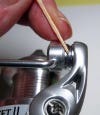Spinning Reels: How to Check Your Line Roller
We may earn revenue from the products available on this page and participate in affiliate programs. Learn more › We’ve...

We may earn revenue from the products available on this page and participate in affiliate programs. Learn more ›

We’ve talked here off and on about maintaining and repairing your fishing reels. Some people take great care with this. Some don’t. For those who do–or those who might want to–here’s a simple spinning-reel tip: Check your line roller.
Located at one end of the bail wire, the line roller is the surface over which the line travels as you reel in line. It needs to roll freely and not simply be stuck in place. This is easy to check with a toothpick pressed against the roller (see photo) to see whether or not the roller rotates easily.
This is important because a line roller that doesn’t move easily will chronically aggravate line twist. Those woeful tangles of monofilament that occur from twisting will happen much more often with a gunked-up, frozen roller.
If the roller won’t move or moves only with difficulty, undo the single screw or nut that holds it in place. Remove the roller along with the bushing or ball-bearing on which it revolves. Clean with solvent, dry and then lubricate with only one drop of lightweight oil during re-assembly. (Cheap reels will have a bushing; expensive models tend to use one or more ball bearings here, which is a lot better.)
Some line twist is endemic to the nature of spinning reels. It’s unavoidable. But what friction at the line roller does is this: It forces line twists forward into the working end of the line, thus making tangles more likely to happen. That’s why your roller needs to actually roll.
That little bit of maintenance now will save you a lot of grief next season. It’s much, much easier than stripping down and cleaning the whole reel. Hey, it’s only one little screw. Don’t be intimidated. Go for it.